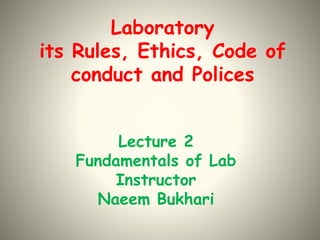
Laboratory ethics
- 1. Laboratory its Rules, Ethics, Code of conduct and Polices Lecture 2 Fundamentals of Lab Instructor Naeem Bukhari
- 2. Classification of medical laboratories • The world Health Organization (WHO) lists four kinds of levels of laboratories based on their biosafety. 1. Basic laboratory level I 2. Basic laboratory level II 3. Containment laboratory (Level III) 4. Maximum containment laboratory
- 3. 1. Basic laboratory level I • Work with organisms which have low risk to the individual laboratory personnel as well as to the members of the community. • Such organisms are categorized under Risk Group I by WHO. • These organisms are unlikely to cause human diseases. Example, food spoilage bacteria, common molds and yeasts.
- 4. 2. Basic laboratory level II • Basic laboratory level II is suitable for work with organisms that influence to moderate risk to the laboratory worker and a limited risk to the members of the community. • Such organisms are categorized under Risk Group II by WHO. • They can cause serious human diseases but not serious hazards due to the availability of effective preventive measures and treatment. Example, staphylococci, streptococci, entero bacteria. • Such laboratory should be clean, provide enough space, have adequate sanitary facilities and equipped with autoclave.
- 5. 3. Containment laboratory (Level III) • Containment laboratory is more advanced and it is used for work with infectious organisms that present a high risk to the laboratory personnel but a lower risk to the community. • Such organisms are categorized under Risk Group III by WHO. Example, Tubercle bacilli, Salmonella typhi and others. • The principle is to remove from the basic laboratory those organisms and activities which are particularly hazardous. • They are easily transmitted through airborne, ingestion of contaminated food or water. • Such laboratory should be a separate room with controlled access by authorized staff. It should also be fitted with microbial safety cabinet.
- 6. 4. Maximum containment laboratory • Maximum containment laboratory is intended for work with viruses, which predispose to a high risk for both laboratory personnel and the community. • Such organisms are categorized under Risk Group IV by WHO. Example, Small pox, Ebola, Lassa fever and others. • Most of these organisms cause serious disease and readily transmitted from on person to another. • These laboratories are usually a separate building with strictly controlled access.
- 7. Rules of medical laboratory A. Medical Laboratory request form B. Keeping of laboratory records C. Delivery of laboratory results
- 8. A. Medical Laboratory request form • Many different types of laboratories requests are received daily in a medical laboratory. • Laboratory request form should be made in writing and provide the following information: 1. The patients identification (full name, age, sex, address) 2. In patient or out patient identification number. 3. Specific test(s) required and date requested. 4. Type of specimen provided. 5. Name of medical officer requesting the test and to whom the report should be sent. 6. Any other information relevant to the test requested.
- 9. B. Keeping of laboratory records • The laboratory must keep a record of all results and it should contain: 1. Patient’s identification (name, age, sex, full address) 2. Type of the specimen (s) 3. Type of test(s) done 4. Date and result(s) of the test (s).
- 10. C. Delivery of laboratory results To ensure the validity and accuracy of test results, the following points should be taken into consideration. 1. Experienced member of medical laboratory professional must check all laboratory results before dispatching them to respective departments or units. 2. Any unexpected result should be investigated and repeated if necessary. 3. If possible, reference values (normal ranges) should be included in reports.
- 11. Professional code of conduct and ethics Major codes of professional conduct are enumerated below: 1. Be loyal to your medical laboratory profession by maintaining high standards of work and by improving your professional skills and knowledge. 2. Work scientifically and with complete honesty. 3. Do not misuse your professional skills or knowledge for personal gain. 4. Never take any thing from your place of work that does not belong to you. 5. Do not disclose to a patient or any unauthorized person the results of your investigation.
- 12. 7. Treat your results and your patient’s information with strict confidentiality. 8. Respect colleagues and work in harmony. 9. Be sympathetic and considerate to the sick and their relatives. 10.Promote health care and the prevention and control of disease. 11.Follow safety precautions and know how to apply first aid. 12.Do not consume alcohol or any other abusive substances during working hours or when on emergency standby. 13.Use equipment and laboratory wares correctly and with care. 14.Do not waste reagents or other laboratory supplies.
- 13. Laboratory policies Laboratory policies are those decisions, which are taken in consultation with other medical staff to enable a laboratory to operate reliably and effectively in harmony with other departments. These polices usually cover: A. Laboratory hour and emergency work B. Range of tests to be performed and those to be referred to higher level. C. Collection of laboratory specimen D. Workload capacity of a laboratory